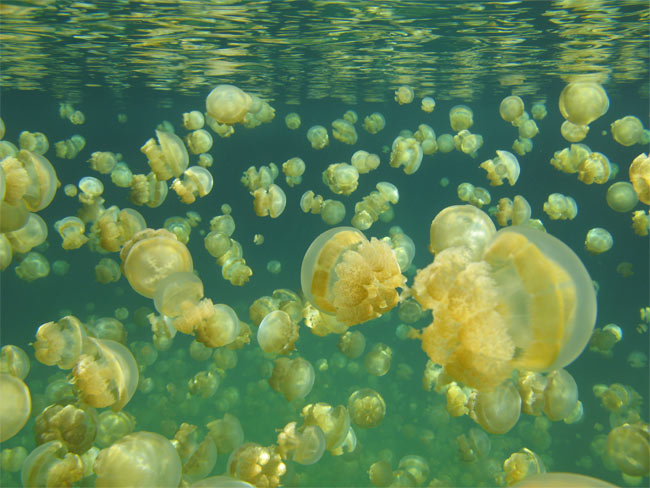Jellyfish Swarms: Menacing or Misunderstood?

They sting, even kill, swimmers. They block the cooling systems of power plants. They clog fishing nets and kill penned salmon.
In recent years, reports of havoc caused by swarms of jellyfish have inspired speculation that these simple, otherworldly creatures are capitalizing on changes we have brought to ocean ecosystems.
Scientists are finding we could be jellyfish's potential benefactors. Overfishing relieves them of competition and predators. Nutrient-rich pollution can cause phytoplankton blooms, providing feasts for some jellies and reducing the water's oxygen content, which could favor their high tolerance for low oxygen. The warmth of climate change could foster expansion among some species. We transport invasive species to new environments, where they thrive. And coastal development provides new shelter for the jellies' stationary life stage, called a polyp.
An article called "The Jellyfish Joyride," published in 2009 in the journal Trends in Ecology and Evolution, discusses the theory that, without a change on our part, these pressures could push ecosystems topped by fish and marine mammals to devolve into ones dominated by jellyfish, as they may have been 500 million years ago.
It is exactly the type of summary Steven Haddock dislikes.
Too easily villainized?
As Haddock, who studies gelatinous plankton at the Monterey Bay Aquarium Research Institute in California, sees it, reports on jellies' potential to overrun the seas resemble monster movies, inaccurately portraying and unfairly demonizing these creatures.
Get the world’s most fascinating discoveries delivered straight to your inbox.
"So you end up with this kind of imaginary animal that has all these properties, which actually no one jellyfish has," Haddock said. "Basically, jellyfish need to eat, and jellyfish are eaten by things as well, so they are part of a healthy ecosystem."
The term "jellyfish" is a slippery one. In general use, it encompasses two groups: Cnidaria, a diverse group of animals armed with stinging cells, which include corals and true jellies — typically, the gelatinous creatures beachgoers encounter. The others are the Ctenophores or comb jellies, which use rows of tiny hairs, called cilia, to swim — and they don't sting. Fossil evidence of both dates back to the Cambrian Period, which lasted from 543 million to 490 million years ago.
Blooms occur when polyps, the early life stage, of some Cnidaria jellies bud off to form the free-floating, umbrella-shaped medusae, which we think of as jellyfish. The polyps bud simultaneously, and one can produce many medusae, creating – depending on one's perspective – blooms or swarms of jellies. Comb jellies, hermaphrodites that release eggs and sperm simultaneously, can also create blooms when they reproduce.
In Japan, conflicts with jellyfish have climbed in recent years, as populations of moon jellies and the giant Nomura's jellyfish, which grow up to 6.7 feet (2 meters) in diameter, have clogged fishing nets and power-plant intakes.
While there is no doubt that these jellies are showing up more frequently in Japanese waters, it's not clear whether the blooms are more intense than years prior, because scientists cannot determine the population sizes, according to Shin-ichi Uye, a professor at the Graduate School of Biosphere Science at Hiroshima University.
Based on the seeming increase in blooms around Japan and elsewhere in the East Asian seas, Uye suspects the increases are global in scale and attributable to human activities like overfishing, coastal construction and nutrient pollution, as well as warming waters.
"However, I admit that the data are not sufficient enough" to conclude that the phenomenon is global, he told LiveScience in an e-mail. "In fact, I paid no attention to jellyfish until they became increasingly problematic in fisheries in [the] 1990s."
No solid baseline
Scientific studies of jellyfish increased toward the end of the last century, but they were significantly outpaced by jellyfish stories in the popular press, indicating the hype may be media-driven, said Rob Condon, one of the lead investigators for the National Center for Ecological Analysis and Synthesis jellyfish working group. The group is examining the hypothesis that increases in jellyfish blooms are occurring worldwide.
A conclusion would be premature, according to Condon.
"The big thing here is an 'if,' and the jury is still out on this," he said. "I say, 'Show me the numbers.' Undoubtedly there are localized areas where blooms have increased. … On a global scale, we don't know enough about jellyfish populations, their biology, their distribution, to make a judgment."
His group is trying to get to the bottom of this, looking at the limited data available both from government and scientific reports, and building a database that will outlive the two-year project. Public outreach is also part of the mission; anyone can submit a sighting on a website (jellywatch.org), and the group is holding an outreach event in Santa Barbara, Calif., on Nov. 20.
Because long-term data on jellyfish populations are limited, Lucas Brotz, a graduate student at the University of British Columbia, also has been looking at anecdotal information — reports in newspapers or from those who work at sea. He said he is seeing evidence of population increases but is not yet prepared to say if they are significant.
"One of the problems with identifying changes in jellyfish populations is they fluctuate with so much variability. One year you see a million, and the next year there won't be any," Brotz said.
No simple answers
Although researchers have attempted to correlate environmental changes with jellyfish populations, it's often difficult to draw a straight line between them.
There is evidence that some species of jellyfish increase or expand as waters warm. However , a complex scenario played out 10 years ago in the Bering Sea, near Alaska, contradicts that.
Trawl data collected by the Alaska Fisheries Science Center revealed that numbers of jellyfish, primarily the sea nettle, grew rapidly throughout the 1990s in the Bering Sea, while temperatures were moderate. The catches peaked in the summer of 2000, at about 40 times larger than in 1982, and the jellyfish also expanded their range. Then they began to decline, while the sea warmed markedly.
The decline may have occurred when the jellyfish food supply — fish and tiny floating animals called zooplankton — could no longer support their growing appetites, according to a 2008 study in the journal Progress in Oceanography. When conditions for zooplankton blooms were optimal, the jellyfish populations grew.
A similarly complex relationship between jellyfish and certain fish — which eat each other's young — may give the jellyfish an advantage in overfished waters. This phenomenon may have suppressed the recovery of Namibia's sardine and anchovy fisheries after they collapsed, according to Mark Gibbons, a plankton biologist at the University of the Western Cape in South Africa.
There is also a large unknown factoring into the population changes seen in the Bering Sea, since scientists have little information about where jellyfish polyps bud off to form the familiar medusa and about the conditions needed for the life-stage change.
"Our understanding of the basic polyp life history is almost negligible," Gibbons said. It is known that polyps can stay attached for very long periods of time, and if the environment becomes hostile they can effectively shut down and then "come back to life." They can also bud off more polyps under certain conditions. However, the factors influencing their behavior are poorly understood in most species, he wrote in an e-mail to LiveScience.
Unfairly villainized?
Jellyfish blooms are nothing new; these sudden proliferations of medusa are recorded in the fossil record more than 500 million years ago. "So it is hard to know if that is any different than it was a long time ago," according to Haddock.
Haddock, also a member of the NCEAS working group, said he came across a 1925 study of jellyfish reproduction, which the author speculated would help explain the masses of jellyfish that had washed up onto the beach in Monterey Bay. "Even for him in 1925, it went without saying, yeah, we get these big jellyfish blooms all the time."
- Album: Jellyfish Rule!
- Dangers in the Deep: 10 Scariest Sea Creatures
- Image Gallery: Rich Life Under the Sea

